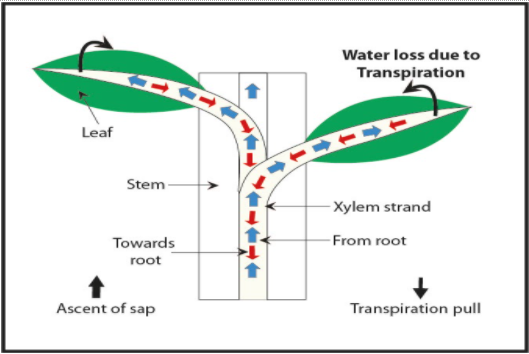
Answer
457.2k+ views
Hint: The xylem tissue is involved in the ascent of sap which is the upward movement of water and minerals from the root to the crown part of the plant. It is used to transport nutrients and water to the leaves to carry out photosynthesis.
Complete answer:
-The xylem is a complex tissue consisting of both living and non-living cells.
-The conducting cells in xylem are typically non-living called tracheids and xylem vessels.
-Both of these cells have thick, lignified secondary cell walls and are dead at maturity.
-Several mechanisms have been proposed to explain the phenomenon but the cohesion-tension mechanism has been found to be most evident.
-The cohesion-tension hypothesis was proposed simultaneously by two groups of scientists Dixon and Joly in the UK and Askenasy in Germany.
-The principle of this mechanism is that water is assumed to form a continuous column extending from the growing shoots and leaves to the roots. Evaporation from the surface of the mesophyll leaves of the leaf provides the driving force for water movement and thus increases their suction force resulting in the withdrawal of water from the dead xylem cells.
-This puts the column in strain. The xylem cells merely act as inert tubes and are of considerable importance because they prevent the collapse of the water column and also prevent the entry of bubbles.
-The column resists breaking because of the cohesive and adhesive forces between the water molecules.
-Water covers the surfaces of the mesophyll cells as a thin film, adhering to cellulose and the other hydrophilic surfaces.
-Evaporation into the leaf spaces causes the water-air interface to retreat into the small spaces between cellulose microfibrils and at the junctions of leaf mesophyll cells.
-As the water retreats, the resulting surface tension pulls water from the adjacent cells.
-Since the water column is continuous, this tension is transmitted through the column, ultimately down to the roots and soil water.
Note: -When the atmospheric pressure is reduced, air enters a wound.
-Water tends to evaporate, filling the tracheid (cavitation) followed by the release of dissolved gases in the form of bubbles of air, thus blocking the movement of water.

Complete answer:
-The xylem is a complex tissue consisting of both living and non-living cells.
-The conducting cells in xylem are typically non-living called tracheids and xylem vessels.
-Both of these cells have thick, lignified secondary cell walls and are dead at maturity.
-Several mechanisms have been proposed to explain the phenomenon but the cohesion-tension mechanism has been found to be most evident.
-The cohesion-tension hypothesis was proposed simultaneously by two groups of scientists Dixon and Joly in the UK and Askenasy in Germany.
-The principle of this mechanism is that water is assumed to form a continuous column extending from the growing shoots and leaves to the roots. Evaporation from the surface of the mesophyll leaves of the leaf provides the driving force for water movement and thus increases their suction force resulting in the withdrawal of water from the dead xylem cells.
-This puts the column in strain. The xylem cells merely act as inert tubes and are of considerable importance because they prevent the collapse of the water column and also prevent the entry of bubbles.
-The column resists breaking because of the cohesive and adhesive forces between the water molecules.
-Water covers the surfaces of the mesophyll cells as a thin film, adhering to cellulose and the other hydrophilic surfaces.
-Evaporation into the leaf spaces causes the water-air interface to retreat into the small spaces between cellulose microfibrils and at the junctions of leaf mesophyll cells.
-As the water retreats, the resulting surface tension pulls water from the adjacent cells.
-Since the water column is continuous, this tension is transmitted through the column, ultimately down to the roots and soil water.
Note: -When the atmospheric pressure is reduced, air enters a wound.
-Water tends to evaporate, filling the tracheid (cavitation) followed by the release of dissolved gases in the form of bubbles of air, thus blocking the movement of water.

Recently Updated Pages
What happens to the gravitational force between two class 11 physics NEET

In the reaction 2NH4 + + 6NO3 aq + 4H + aq to 6NO2g class 11 chemistry JEE_Main

A weightless rod is acted upon by upward parallel forces class 11 phy sec 1 JEE_Main

From a uniform circular disc of radius R and mass 9 class 11 physics JEE_Main

From a solid sphere of mass M and radius R a cube of class 11 phy sec 1 JEE_Main

A slender uniform rod of mass m and length l is pivoted class 11 physics JEE_Main

Trending doubts
Which is the longest day and shortest night in the class 11 sst CBSE

Who was the Governor general of India at the time of class 11 social science CBSE

Why is steel more elastic than rubber class 11 physics CBSE

Difference between Prokaryotic cell and Eukaryotic class 11 biology CBSE

Define the term system surroundings open system closed class 11 chemistry CBSE

In a democracy the final decisionmaking power rests class 11 social science CBSE




